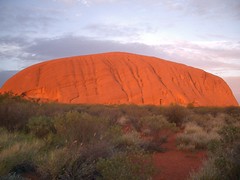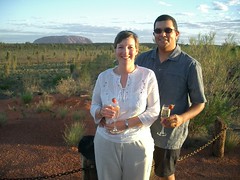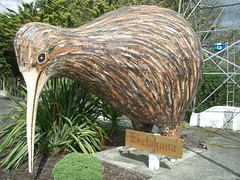Wednesday, February 22, 2006
Uluru-Kata Tjuta National Park
 It's taken us two visits to Australia but we've finally made it to the middle, and one of the most recognisable natural landmarks in the world. Or, to put it another way, we've got on another plane and flown for two hours into the middle of nowhere to see yet another old rock. Quite an impressive rock though. The fact that it really is in the middle of nowhere seems to add to the effect, although it also makes it difficult to judge the size from a distance because there are so few reference points. The approach to the runway seemed to involve a big turn that meant both sides of the plane got a good look and a chance for some photos, don't know whether it was really for the benefit of the tourists or not!
It's taken us two visits to Australia but we've finally made it to the middle, and one of the most recognisable natural landmarks in the world. Or, to put it another way, we've got on another plane and flown for two hours into the middle of nowhere to see yet another old rock. Quite an impressive rock though. The fact that it really is in the middle of nowhere seems to add to the effect, although it also makes it difficult to judge the size from a distance because there are so few reference points. The approach to the runway seemed to involve a big turn that meant both sides of the plane got a good look and a chance for some photos, don't know whether it was really for the benefit of the tourists or not!The airport shuttle is free, but then it doesn't take you that far and there is only one resort that you can stay at anyway! There is though a wide range of accommodation, starting with a campsite and working up. After many weeks of consideration we had finally, and with some disappointment, settled for a 'cabin' in the campsite (the tents are cheaper, but this is not the season to be without air-conditioning!). We had tried to persuade ourselves that we could afford to treat ourselves to a stay at Longitude 131 (well, Nikky had insisted that my redundancy would cover it), but we eventually decided that £1,500 for two nights was not really in line with our budget! Maybe next time.
The resort is about 15km from the rock and most people seem to get there either on a coach tour or on the (not free) shuttle bus. Neither of these are particularly cheap, and considering the limited amount of time we've seen coach tours stop at most places we decided to hire a car for a day (bike hire is available for the insane!). The first stop inside the National Park is the Aboriginal Cultural centre. Most of the coach tours seem to stop for about 30 minutes here, but this isn't really anywhere near long enough as we spent well over an hour inside and didn't read everything or watch all the videos.
As you get closer to the rock you realise that it isn't quite such a simple shape as it seems in all the photos you've seen. It always looks very rectangular to me, but in some of the aerial shots it actually looks almost triangular. Most photos you see are also taken from quite a distance to get it all in so we didn't expect the surface to be as interesting as it is. There are small areas of unusual shapes and it's covered in potholes, cracks and different coloured marks. Many of these features are central to the 'Dreaming' stories of the local people which explain how Uluru was created.
Having done a 'lap' of Uluru and taken more pictures than any sane person could possibly want of the same rock we headed off to Kata Tjuta about 50km away. Named by the Europeans as The Olgas, the individual rocks are smaller but they cover a larger area than Uluru. We did a short walk here but were unable to go any further as some areas are closed off when the temperature is above 36 degrees (not that we were planning to do too much strenuous walking in that heat anyway). Climbing Uluru is also off limits when the temperatures reach that level, although you are kindly asked to respect the wishes of the locals and not climb it anyway. (It's a sacred site, so the 'No Climb' request is really quite reasonable when you consider how offended many people would be if thousands of tourists decided to clamber up the outside of churches and mosques just so they could buy a t-shirt celebrating their efforts).
After Kata Tjuta we headed back to Uluru to join the dozens of people parked up to take photos of the rock at sunset. We're here at a relatively quiet time of year, so it must be chaos in the peak season. Some people have got proper tripods, others have rigged up elaborate constructions involving coolboxes and chairs, and others (like us) are just attempting to balance cameras on the roof of a car. Whichever method has been chosen we are all sitting there, very carefully lining up our cameras in order that we can all take dozens of almost identical pictures as the sun sets (we'd been given a tip to take a picture every 5 minutes). We didn't have the best sunset because of some low cloud, but it still kept most people snapping away until it was almost completely dark.
After sunset it was back to 'camp' for an early night, before getting up at 5am to drive all the way back for sunrise. Sunrise was even more crowded than sunset, cars and coaches just lined up at the side of the road, everyone trying to pick the perfect parking spot where they can stick the camera on the roof of the car and not have a tree obscuring their photos! This time I think we took even more photos, and also got a few more good 'Random Tourists' pictures. Proving the rule that, however early you arrive and however good the position you pick, someone will always turn up late and stand right in front of you. In this case they even took it a stage further and decided that, since it was a bit tiring to stand, they would just lean back and rest on our hire car!!! And then, as soon as the sun finaly clears the horizon everyone is back in their cars and headed back to the resort for breakfast, or in our case to check out and catch the bus to Alice Springs.
We've tried not to publish too many of the photos, so there is a set of general Uluru pictures, but there are also separate sets for sunset and sunrise if you really want to have a look. (There are even more taken with the 'Sunset' filter setting on one of our cameras for the truly dedicated, or if you are really bored at work!).



